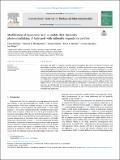| dc.contributor.author | Buckley, Ciara | |
| dc.contributor.author | Montgomery, Therese R. | |
| dc.contributor.author | Szank, Tomasz | |
| dc.contributor.author | Murray, Brian A. | |
| dc.contributor.author | Quigley, Cormac | |
| dc.date.accessioned | 2023-05-04T10:57:58Z | |
| dc.date.available | 2023-05-04T10:57:58Z | |
| dc.date.copyright | 2023 | |
| dc.date.issued | 2023-06-15 | |
| dc.identifier.citation | Buckley, C., Montgomery, T.R., Szank, T., Murray, B. A., Quigley, C. (2023). Modification of hyaluronic acid to enable click chemistry photo-crosslinking of hydrogels with tailorable degradation profiles. International Journal of Biological Macromolecules. 15 June. 124459. https://doi.org/10.1016/j.ijbiomac.2023.124459 | en_US |
| dc.identifier.issn | 0141-8310 | |
| dc.identifier.uri | https://research.thea.ie/handle/20.500.12065/4501 | |
| dc.description.abstract | Hyaluronic acid (HA) is a naturally occurring mucopolysaccharide that, due to its inherent bioactivity and extracellular matrix-like structure, has the potential to be utilised extensively in tissue engineering. However, this glycosaminoglycan lacks the properties required for cellular adhesion and photo-crosslinking by UV light, which significantly hinders this polymers applicability. This research presents a method for modifying hyaluronic acid via thiolation and methacrylation to generate a novel photo-crosslinkable polymer with improved physicochemical properties, biocompatibility and the potential to customize biodegradability according to the ratio of monomers used. A decrease in stiffness proportional to increasing thiol concentration was observed when testing the compressive strength of hydrogels. Conversely, it was noted that the storage moduli of hydrogels increased proportionally to thiol concentration indicating a greater degree of cross-linking with the addition of thiol. The addition of thiol to HA increased the biocompatibility of the material in both neuronal and glial cell lines and improved the degradability of methacrylated HA. Due to the enhanced physicochemical properties and biocompatibility imparted by the introduction of thiolated HA, this novel hydrogel system could have numerous bioengineering applications. | en_US |
| dc.format | PDF | en_US |
| dc.language.iso | eng | en_US |
| dc.publisher | Elsevier | en_US |
| dc.relation.ispartof | International Journal of Biological Macromolecules | en_US |
| dc.rights | Attribution 3.0 United States | * |
| dc.rights.uri | http://creativecommons.org/licenses/by/3.0/us/ | * |
| dc.subject | Hylauronic acid | en_US |
| dc.subject | Photopolymerisation | en_US |
| dc.subject | Click-chemistry | en_US |
| dc.title | Modification of hyaluronic acid to enable click chemistry photo-crosslinking of hydrogels with tailorable degradation profiles | en_US |
| dc.type | info:eu-repo/semantics/article | en_US |
| dc.contributor.affiliation | Technological University of the Shannon: Midlands Midwest | en_US |
| dc.contributor.sponsor | Irish Research Council | en_US |
| dc.description.peerreview | yes | en_US |
| dc.identifier.doi | 10.1016/j.ijbiomac.2023.124459 | en_US |
| dc.identifier.eissn | 1879-0003 | |
| dc.identifier.orcid | https://orcid.org/0000-0001-9843-340X | en_US |
| dc.identifier.orcid | https://orcid.org/0000-0003-2749-5376 | en_US |
| dc.identifier.orcid | https://orcid.org/0000-0003-3939-1275 | en_US |
| dc.rights.accessrights | info:eu-repo/semantics/openAccess | en_US |
| dc.subject.department | PRISM: Polymer, Recycling, Industrial, Sustainability and Manufacturing Institute: TUS Midlands | en_US |
| dc.type.version | info:eu-repo/semantics/publishedVersion | en_US |


